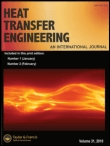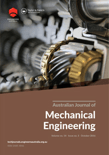
JOURNAL OF TURBOMACHINERY-TRANSACTIONS OF THE ASME
Scope & Guideline
Connecting Researchers and Practitioners in Turbomachinery
Introduction
Aims and Scopes
- Turbomachinery Performance Optimization:
Research dedicated to improving the aerodynamic and thermodynamic performance of various turbomachinery components, including turbines, compressors, and fans, through innovative design methodologies. - Heat Transfer and Cooling Techniques:
Exploration of advanced cooling methodologies, including film cooling, impingement cooling, and heat transfer mechanisms in turbomachinery, which are crucial for enhancing efficiency and durability. - Fluid Dynamics and Flow Control:
Investigation of fluid dynamics including turbulence modeling, flow separation, and control techniques to optimize performance and mitigate losses in turbomachinery applications. - Experimental and Computational Methods:
Application of both experimental techniques and computational fluid dynamics (CFD) to validate and improve models, ensuring high accuracy in predicting behavior and performance of turbomachinery. - Material and Manufacturing Innovations:
Research into the impact of advanced materials and manufacturing techniques, such as additive manufacturing, on the performance and reliability of turbomachinery components.
Trending and Emerging
- Machine Learning and Data-Driven Approaches:
The integration of machine learning techniques into turbomachinery research is on the rise, with applications in optimizing design, predicting performance, and enhancing turbulence modeling. - Additive Manufacturing Techniques:
Research focusing on the application of additive manufacturing in the production of complex turbomachinery components is gaining momentum, highlighting its potential for improved performance and reduced manufacturing costs. - Advanced Cooling Technologies:
Emerging cooling technologies, such as novel film cooling designs and hybrid cooling strategies, are being increasingly explored to enhance the thermal performance of high-efficiency turbines. - Unsteady Flow Dynamics:
There is a growing emphasis on understanding unsteady flow phenomena, including transient behaviors and their impacts on turbomachinery performance, which are crucial for improving operational reliability. - Multi-Physics and Multi-Scale Modeling:
The trend toward multi-physics and multi-scale modeling approaches is becoming prominent, enabling more comprehensive analyses of turbomachinery systems under various operating conditions.
Declining or Waning
- Basic Theoretical Models:
There has been a noticeable decrease in the publication of papers relying solely on traditional theoretical models without experimental or computational validation, as the field moves toward more data-driven and experimentally validated approaches. - Conventional Cooling Techniques:
Research on conventional cooling techniques has waned, with a shift towards innovative cooling designs and advanced materials, reflecting a trend towards more effective and efficient cooling solutions. - Generic Turbomachinery Applications:
Papers focusing on generic applications of turbomachinery without specific industrial contexts are becoming less frequent, as researchers are increasingly targeting niche applications and specific performance challenges. - Low-Fidelity Simulations:
There is a declining interest in low-fidelity simulation methods in favor of high-fidelity computational models that provide more accurate predictions of turbomachinery performance.
Similar Journals

STROJNISKI VESTNIK-JOURNAL OF MECHANICAL ENGINEERING
Fostering Innovation Through Rigorous ResearchSTROJNISKI VESTNIK-JOURNAL OF MECHANICAL ENGINEERING is a prestigious publication that has been disseminating cutting-edge research in the field of mechanical engineering since 1974. Published by the Association of Mechanical Engineers Technicians Slovenia, this journal serves as a critical platform for professionals, researchers, and students aiming to explore advancements in mechanical engineering and mechanics of materials. With a category ranking in the Q3 quartile for both Mechanical Engineering and Mechanics of Materials, the journal reflects a robust engagement with contemporary research and practices, contributing to the ongoing discourse within these vital disciplines. Although currently not open access, the journal is committed to providing high-quality, peer-reviewed articles that facilitate knowledge sharing and innovation. It is indexed in Scopus, maintaining respectable standings within its categories, thereby underlining its importance and impact in the global academic community.

JOURNAL OF FLUIDS ENGINEERING-TRANSACTIONS OF THE ASME
Exploring the Depths of Fluid DynamicsJOURNAL OF FLUIDS ENGINEERING-TRANSACTIONS OF THE ASME, published by the renowned American Society of Mechanical Engineers (ASME), stands as a pivotal platform for disseminating cutting-edge research in the field of mechanical engineering, specifically focusing on fluid mechanics and its diverse applications. With an established history dating back to 1897, this journal features research that pushes the boundaries of knowledge and technology in areas such as fluid dynamics, thermal engineering, and hydrodynamics. Although it is not an open-access journal, it maintains rigorous peer-review standards, ensuring the publication of high-quality scholarly articles that contribute to the academic and professional community. In the latest rankings, it holds a respectable position within the Q2 category of mechanical engineering journals, reflecting its significant impact, as evidenced by its Scopus rank of #204 out of 672, placing it in the 69th percentile. Researchers, professionals, and students alike will find this journal to be a vital resource for the latest developments and innovative insights in fluids engineering.

Journal of Nanofluids
Fostering Global Collaboration in Nanofluid ResearchJournal of Nanofluids, published by AMER SCIENTIFIC PUBLISHERS, is a leading international journal dedicated to the burgeoning field of nanofluid technology which bridges the areas of fluid dynamics and nanotechnology. With an ISSN of 2169-432X and E-ISSN of 2169-4338, this journal has established itself as a valuable resource for researchers and professionals in Mechanical Engineering and Chemical Engineering, particularly in the domains of fluid flow and transfer processes. Its prestigious standing is reflected in the 2023 Scopus rankings, positioning it in the 79th percentile for Mechanical Engineering and the 78th percentile for Fluid Flow and Transfer Processes. Although coverage has been discontinued in Scopus since 2021, the journal maintains a Q2 category ranking in both relevant fields, emphasizing its commitment to high-quality and impactful research dissemination. This journal aims to foster innovation and collaboration among scientists and engineers worldwide, providing a platform for groundbreaking research, reviews, and discussions on nanofluids, their properties, and applications. As an essential addition to the library of any researcher or student vested in advanced fluid dynamics, the Journal of Nanofluids serves as a pivotal conduit for advancing knowledge and technology in this exciting and evolving field.

Frontiers in Mechanical Engineering-Switzerland
Advancing Innovations in Mechanical EngineeringFrontiers in Mechanical Engineering-Switzerland, published by FRONTIERS MEDIA SA, is a pioneering open-access journal that has been fostering innovations in the field of mechanical engineering since its inception in 2015. Based in Switzerland, this journal provides a robust platform for disseminating cutting-edge research across multiple disciplines within mechanical engineering, including materials science, industrial and manufacturing engineering, and computer science applications. With impressive Scopus rankings, including Q2 statuses in key categories such as Industrial and Manufacturing Engineering and Mechanical Engineering, it stands out as a valuable resource for researchers and practitioners aiming to stay abreast of trends and breakthroughs in these fields. By embracing open-access principles, the journal ensures that high-quality research is readily available to a global audience, thereby promoting collaboration and knowledge sharing. As it continues to grow, Frontiers in Mechanical Engineering is poised to make significant contributions to both academic and professional communities, enhancing understanding and advancing practices in engineering disciplines.

HEAT TRANSFER RESEARCH
Innovating Insights in Heat Transfer and Fluid FlowHEAT TRANSFER RESEARCH is a leading academic journal published by Begell House Inc that focuses on the dynamic and evolving fields of heat transfer, fluid flow, and mechanical engineering. With an ISSN of 1064-2285 and an E-ISSN of 2162-6561, this journal serves as a critical platform for researchers and professionals seeking to disseminate innovative findings and advancements in these interrelated disciplines. Covering converged years from 1992 to 2024, HEAT TRANSFER RESEARCH has established its impact in the academic community, achieving a 2023 ranking of Q3 in Condensed Matter Physics and Q2 in Fluid Flow and Transfer Processes. It currently occupies a percentile rank ranging from 44th to 54th across several Scopus categories, underscoring its relevance and contribution to the scientific discourse. While Open Access options are not available, the journal remains committed to providing high-quality research and insights that shape the future of thermal sciences. Accessible to both seasoned professionals and aspiring students, HEAT TRANSFER RESEARCH is indispensable for anyone looking to stay ahead in the ever-changing landscape of engineering and applied physics.

HEAT TRANSFER ENGINEERING
Driving the evolution of thermal management and engineering.HEAT TRANSFER ENGINEERING is a leading international journal published by Taylor & Francis Inc, dedicated to advancing the field of heat transfer and thermal engineering. With a strong focus on the key aspects of Condensed Matter Physics, Fluid Flow and Transfer Processes, and Mechanical Engineering, this journal covers a comprehensive range of topics from experimental studies to theoretical analysis, aiming to foster innovative research and practical applications. Since its inception in 1979 and continuing through 2024, the journal has established itself as an essential resource for researchers and industry professionals alike, reflected in its solid rankings within Scopus—holding a Q2 quartile classification in multiple engineering disciplines. Although not open access, the journal ensures broad accessibility through institutional subscriptions, making cutting-edge research readily available. With its rigorous peer-review process and commitment to quality, HEAT TRANSFER ENGINEERING plays a crucial role in shaping the future of thermal management solutions and engineering practices.

Transactions of the Korean Society of Mechanical Engineers B
Pioneering insights for the future of mechanical technologies.Welcome to the Transactions of the Korean Society of Mechanical Engineers B, a pivotal journal dedicated to advancing the field of mechanical engineering. Published by the esteemed Korean Society of Mechanical Engineers, this journal serves as a platform for the dissemination of innovative research and practical applications in mechanical engineering and related disciplines. With a focus on fostering knowledge exchange and collaboration, the journal publishes original research articles, reviews, and technical notes that contribute to the understanding and evolution of mechanical systems and technologies. The Transactions of the Korean Society of Mechanical Engineers B, which has been in circulation since 2007 and spans through 2024, is categorized within the Q4 quartile of mechanical engineering rankings and is indexed by Scopus, making it a valuable resource for researchers and professionals aiming to stay abreast of the latest developments in the field. Although it is not open access, its rigorous peer-review process ensures the integrity and quality of the published work, making it essential reading for academics and practitioners alike.

Journal of Applied Mechanics and Technical Physics
Pioneering Research in Mechanics and Condensed MatterJournal of Applied Mechanics and Technical Physics is a distinguished publication that serves as a vital resource for researchers and professionals in the realms of mechanical engineering, mechanics of materials, and condensed matter physics. Published by MAIK NAUKA/INTERPERIODICA/SPRINGER, this journal has been committed to disseminating high-quality research since its inception in 1965. With a noted presence in the academic community, it holds a respectable Q3 ranking in multiple categories as of 2023, indicating its relevance and contribution to the field. Although it does not currently offer open access, the journal provides valuable insights and advancements through its rigorous peer-review process. Covering a broad spectrum of topics in applied mechanics and technical physics, it aims to foster innovation and dialogue among scientists, engineers, and scholars alike. Located in the United States, the journal continues to make significant strides in bridging the gap between theoretical research and practical applications, making it an essential read for anyone engaged in these dynamic fields.

Australian Journal of Mechanical Engineering
Advancing Mechanical Engineering Knowledge for Tomorrow's Innovations.The Australian Journal of Mechanical Engineering is a distinguished publication in the realm of mechanical engineering, dedicated to advancing the knowledge and application of engineering principles within the industry. Published by TAYLOR & FRANCIS LTD in the United Kingdom, this journal has been integral to the field since its inception, featuring a range of peer-reviewed research articles, reviews, and technical notes that collectively aim to bridge theoretical research with practical applications. With an impressive Scopus ranking of #271 out of 672 in Mechanical Engineering, positioning it within the 59th percentile, the journal continues to uphold rigorous academic standards, currently occupying Q3 in the 2023 quartile rankings. Researchers, professionals, and students alike will benefit from its comprehensive coverage and insightful contributions, providing a vital platform for knowledge exchange and innovation in mechanical engineering.

Transactions of the Korean Society of Mechanical Engineers A
Pioneering Insights in Manufacturing and Materials Science.Transactions of the Korean Society of Mechanical Engineers A is a leading academic journal dedicated to the field of mechanical engineering, published by the Korean Society of Mechanical Engineers. With an ISSN of 1226-4873 and an E-ISSN of 2288-5226, this journal serves as a vital platform for disseminating innovative research and advancements in mechanical engineering. Situated in South Korea, the journal aims to foster knowledge exchange among researchers and professionals by publishing high-quality, peer-reviewed articles that cover a broad range of topics, including but not limited to manufacturing processes, thermodynamics, and materials science. Although it currently holds a Q4 ranking in the Mechanical Engineering category and is positioned in the 12th percentile of Scopus rankings, the journal is dedicated to expanding its impact and visibility in the global academic community. As it converges from 2007 to 2024, Transactions of the Korean Society of Mechanical Engineers A represents an essential resource for those seeking to advance their understanding and research within this dynamic discipline.